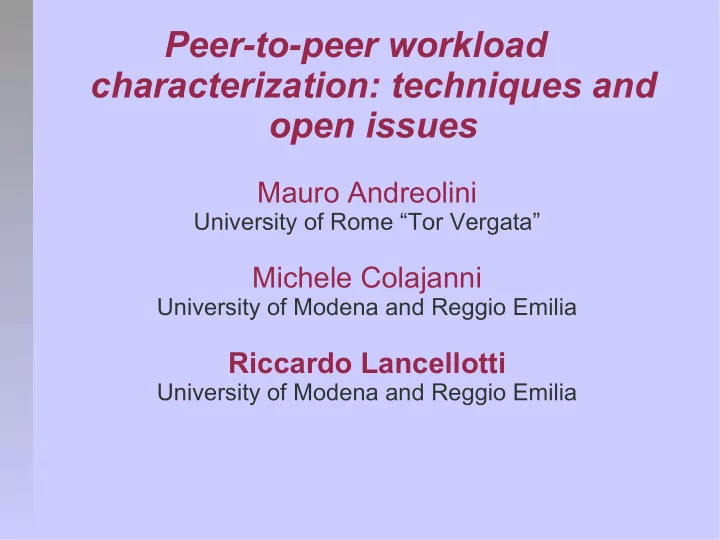

Peer-to-peer workload characterization: techniques and open issues Mauro Andreolini University of Rome “Tor Vergata” Michele Colajanni University of Modena and Reggio Emilia Riccardo Lancellotti University of Modena and Reggio Emilia
Overview of File sharing networks File sharing is the killer application of P2P Peer-to-peer systems Node are peers ( Servents ) Use of overlay network Two functions: Network management and query function Download → Two protocols
Overview of File sharing networks Multiple networks FastTrack/Kazaa Closed management protocol (difficult rev. eng. [Ross]) HTTP-based download Gnutella Open management protocol, O.S. servent HTTP-based download
Workload characterization Data of interest Resource working set User behavior Network structure Collection techniques Active probing (crawling) Passive probing (traffic interception and analy- sis)
Crawling
Crawling Issues Queries can be rejected (e.g., “*” queries) Queries can be deleted after a short amount of time (~15 min). Queries need rejuvination
Crawling Pros Easy to deploy (available O.S. sw) Can run from the network edge Takes a snapshot of the network Allows to collect interesting metadata (e.g. hash) Cons Difficult to analyze dynamic aspects of the network Needs open protocols Difficult to detect poisoning
Traffic interception and analysis
Traffic interception and analysis Issues Analyze large amount of traffic Capture only meaningful traffic Types of meaningful traffic Download Query Network management
Traffic interception and analysis Pros Considers actual file-sharing traffic Allows the observation of dynamic characteris- tics of the network Cons Needs representative traffic Needs open protocols (mainly download traffic)
Taxonomy on file-sharing workload analysis
Analysis on resource working set Studies on file popularity Resource popularity [Leib] 80% of resources, 20% of downloads [Andr] Zipf resource popularity [Gum] Truncated Zipf popularity File type popularity [Leib, Andr] Audio clips most popular resource Keyword popularity in shared files [Makosiej] Analytical model for keyword popularity (60% files are associated with the keyword “Love”) Changes of popularity rank over time [Leib] 20% of files remains popular for long time
Analysis on resource working set Studies on working set size Resource size in the global working set [Leib] histogram of file size, 5 MB most popular size Resources shared by each node [Andr] analytical model of resource shared by nodes
Analysis on resource working set Studies on working set size Resource size according to type [Leib] correlation size/type shared files [Andr] analytical model shared bytes
Analysis of user behavior Definition of user profile Impact of freeloaders [Tow] not always harmful Download time [Gum] users are patient: small files: 30% > 1h, 10% ~1 day large files: 50% > 1 day, 20% > 1 week Aging of users [Gum] After 3-4 weeks users download smaller files less frequently
Analysis of user behavior User activity characterization Session length [Gum] Download session Chunked downloads [Sar] Network session Activity fraction [Gum] median 90-percentile Activity fraction [Gum] 66% 100% Download session length [Gum] 2.40 min 28.33 min Session length [Sar] 60 min 300 min Query activity [Makosiej] Keywords per query, popularity of key- words in queries, types of keywords per query
Characterization of servents and of the overlay network Studies on network topology Relationship between physical and overlay networks [Ripe] completely different topologies Topology of overlay networks [Ripe, Sar] power law network Impact of network topology on resilience [Sar] removing 5% top nodes leads to network parti- tion (interesting if you're interested in enforcing copy- right law)
Characterization of servents and of the overlay network Characterization of servent connectivity Relationship between advertised and actual bandwidth [Sar] DSL-class connectivity [Sar] under-advertised connectivity Types of clients [Sar] 15% of nodes are Server-servent , the remaining are Client-servent
Open issues Comparison between results obtained through crawling and traffic analysis Studies of local and time-related phe- nomenon impact over the network Improvement of packet interception analysis by means of statistical analysis (NetScope)
Recommend
More recommend